Victoria's Day One in London, Part Two
As you might recall, in Part One, Ed and I were standing on Horse Guards Parade, watching a ceremony of mounted riders. Instead of the familiar Red Coats, they were wearing black uniforms, which shocked me. What was the story? Ed was probably thinking more about his sore foot, with its burst blisters and pain with every step.
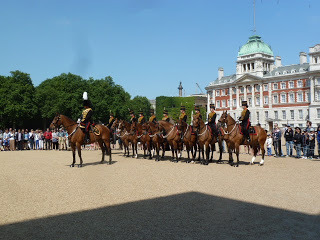 Horse Guards Parade, in the background: the Old Admiralty Building
Horse Guards Parade, in the background: the Old Admiralty Building
And behind us was the museum, with the hope of a seat where Ed could rest his aching foot.
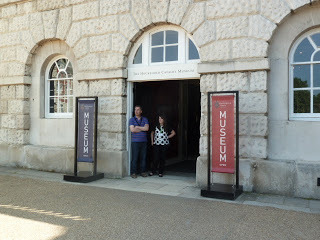 Museum Entrance We entered and paid our admission -- and miraculously there were benches, several of them. One problem solved. Now what about those uniforms? The Guide explained that every summer the Household Cavalry has time away from Horse Guards for maneuvers; their duties are taken over by the King's Troop Royal Horse Artillery, usually stationed at Woolrich. For more information, click here.
Museum Entrance We entered and paid our admission -- and miraculously there were benches, several of them. One problem solved. Now what about those uniforms? The Guide explained that every summer the Household Cavalry has time away from Horse Guards for maneuvers; their duties are taken over by the King's Troop Royal Horse Artillery, usually stationed at Woolrich. For more information, click here.
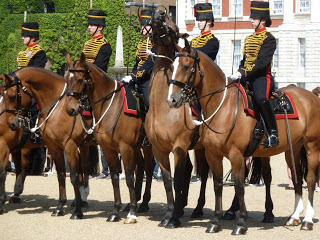 King's Troop Royal Horse Artillery As you might be able to see in the above view, some members of the KTRHA are female. That was a bit of a surprise, though a nice one. This unit is responsible for all the artillery salutes in the park. Click here for an account of the salutes to the new baby Prince George of Cambridge.
King's Troop Royal Horse Artillery As you might be able to see in the above view, some members of the KTRHA are female. That was a bit of a surprise, though a nice one. This unit is responsible for all the artillery salutes in the park. Click here for an account of the salutes to the new baby Prince George of Cambridge.
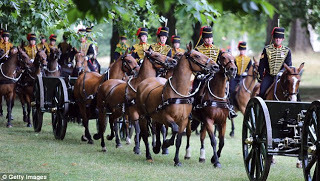 In Green Park, ©Getty Images So, the mystery of the uniforms was solved; I later found out that the King's Troop Royal Horse Artillery uniforms are almost identical to those worn by their predecessor unit in the Battle of Waterloo.
In Green Park, ©Getty Images So, the mystery of the uniforms was solved; I later found out that the King's Troop Royal Horse Artillery uniforms are almost identical to those worn by their predecessor unit in the Battle of Waterloo.
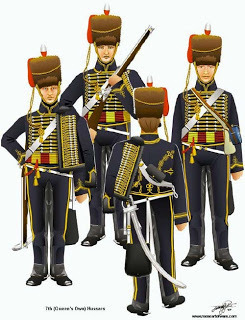 7th (King's Own) Hussars, Waterloo Uniform
7th (King's Own) Hussars, Waterloo Uniform
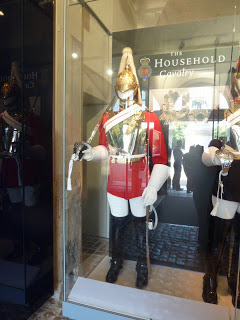 The more familiar Redcoat uniform We found Ed several seats placed conveniently around the museum. Unlike Kristine and me, our hubbies (would you believe I actually wrote hobbies there?) do not necessarily read every word of every text panel in a museum like this.
The more familiar Redcoat uniform We found Ed several seats placed conveniently around the museum. Unlike Kristine and me, our hubbies (would you believe I actually wrote hobbies there?) do not necessarily read every word of every text panel in a museum like this.
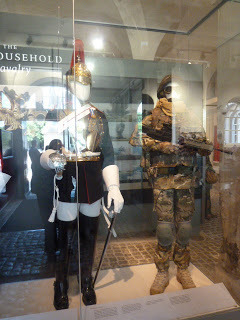 As you can see above (sorry for the reflections, but it was a bright and sunny day, a delight for London), the Household Cavalry wears various uniforms, including the kind of desert camouflage needed in Afghanistan.
As you can see above (sorry for the reflections, but it was a bright and sunny day, a delight for London), the Household Cavalry wears various uniforms, including the kind of desert camouflage needed in Afghanistan.
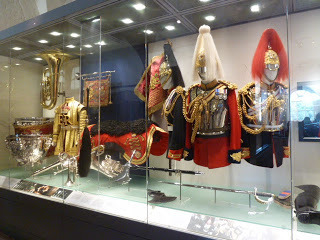 Second in command of the British troops during the Battle of Waterloo was Henry Paget, Earl of Uxbridge (1768-1854) who led the cavalry. In a famous incident at the very end of the battle, Paget and Wellington were side by side on horseback watching the action. A cannon shot hit Paget in the leg. He is reported to have said, "By God, sir, I've lost my leg," to which the Duke responded, "By God, sir, so you have." Thus, the epitome of sang froid.
Second in command of the British troops during the Battle of Waterloo was Henry Paget, Earl of Uxbridge (1768-1854) who led the cavalry. In a famous incident at the very end of the battle, Paget and Wellington were side by side on horseback watching the action. A cannon shot hit Paget in the leg. He is reported to have said, "By God, sir, I've lost my leg," to which the Duke responded, "By God, sir, so you have." Thus, the epitome of sang froid.
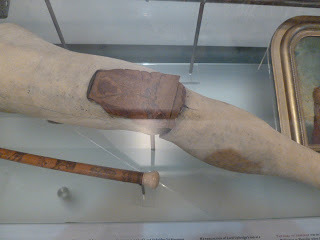 Paget's Artificial leg After the amputation of his leg, Paget recovered and led a long and illustrious career, his need for artificial limbs and his willingness to experiment leading to many advances in the science of prosthetics. Click here for the story of his actual limb and its bizarre fate as told by Kristine.
Paget's Artificial leg After the amputation of his leg, Paget recovered and led a long and illustrious career, his need for artificial limbs and his willingness to experiment leading to many advances in the science of prosthetics. Click here for the story of his actual limb and its bizarre fate as told by Kristine.
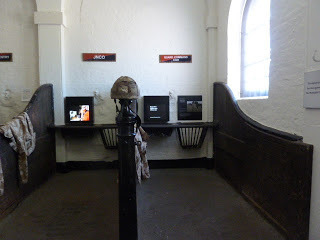 Examples of stalls for the horses For more information on the Household Cavalry Museum, click here.
Examples of stalls for the horses For more information on the Household Cavalry Museum, click here.
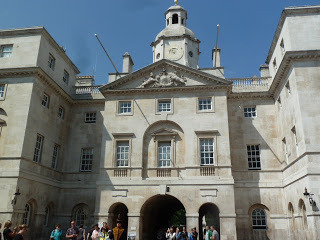 Horse Guards The Duke of Wellington for many years was the commander in chief of the British Army. As such his office was in Horse Guards, in the room directly above the arch.
Horse Guards The Duke of Wellington for many years was the commander in chief of the British Army. As such his office was in Horse Guards, in the room directly above the arch.
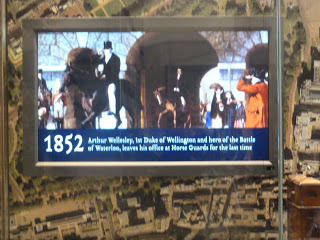 Museum display In the museum, a display tells the story of the Duke and his Armies, and shows a picture of him in leaving Horse Guards for the last time.
Museum display In the museum, a display tells the story of the Duke and his Armies, and shows a picture of him in leaving Horse Guards for the last time.
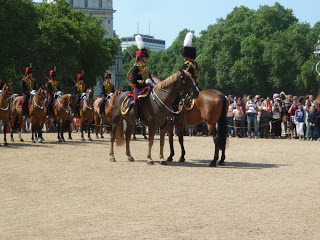 After Ed's foot was adequately rested and I had read every word of the descriptions and explored the small gift shop, we went back outside, where the original troops had been joined by a new set of horsemen and horsewomen. Their commanders seemed to be completing a changing of the guard. With a glance at the crowds of onlookers, Ed led the way back to Whitehall where we grabbed a taxi en route to our next stop, Mallett at 37 Dover Street in Mayfair. More about that in Part Three, coming soon.
After Ed's foot was adequately rested and I had read every word of the descriptions and explored the small gift shop, we went back outside, where the original troops had been joined by a new set of horsemen and horsewomen. Their commanders seemed to be completing a changing of the guard. With a glance at the crowds of onlookers, Ed led the way back to Whitehall where we grabbed a taxi en route to our next stop, Mallett at 37 Dover Street in Mayfair. More about that in Part Three, coming soon.
 Horse Guards Parade, in the background: the Old Admiralty Building
Horse Guards Parade, in the background: the Old Admiralty BuildingAnd behind us was the museum, with the hope of a seat where Ed could rest his aching foot.
 Museum Entrance We entered and paid our admission -- and miraculously there were benches, several of them. One problem solved. Now what about those uniforms? The Guide explained that every summer the Household Cavalry has time away from Horse Guards for maneuvers; their duties are taken over by the King's Troop Royal Horse Artillery, usually stationed at Woolrich. For more information, click here.
Museum Entrance We entered and paid our admission -- and miraculously there were benches, several of them. One problem solved. Now what about those uniforms? The Guide explained that every summer the Household Cavalry has time away from Horse Guards for maneuvers; their duties are taken over by the King's Troop Royal Horse Artillery, usually stationed at Woolrich. For more information, click here.
 King's Troop Royal Horse Artillery As you might be able to see in the above view, some members of the KTRHA are female. That was a bit of a surprise, though a nice one. This unit is responsible for all the artillery salutes in the park. Click here for an account of the salutes to the new baby Prince George of Cambridge.
King's Troop Royal Horse Artillery As you might be able to see in the above view, some members of the KTRHA are female. That was a bit of a surprise, though a nice one. This unit is responsible for all the artillery salutes in the park. Click here for an account of the salutes to the new baby Prince George of Cambridge.
 In Green Park, ©Getty Images So, the mystery of the uniforms was solved; I later found out that the King's Troop Royal Horse Artillery uniforms are almost identical to those worn by their predecessor unit in the Battle of Waterloo.
In Green Park, ©Getty Images So, the mystery of the uniforms was solved; I later found out that the King's Troop Royal Horse Artillery uniforms are almost identical to those worn by their predecessor unit in the Battle of Waterloo.
 7th (King's Own) Hussars, Waterloo Uniform
7th (King's Own) Hussars, Waterloo Uniform
 The more familiar Redcoat uniform We found Ed several seats placed conveniently around the museum. Unlike Kristine and me, our hubbies (would you believe I actually wrote hobbies there?) do not necessarily read every word of every text panel in a museum like this.
The more familiar Redcoat uniform We found Ed several seats placed conveniently around the museum. Unlike Kristine and me, our hubbies (would you believe I actually wrote hobbies there?) do not necessarily read every word of every text panel in a museum like this.
 As you can see above (sorry for the reflections, but it was a bright and sunny day, a delight for London), the Household Cavalry wears various uniforms, including the kind of desert camouflage needed in Afghanistan.
As you can see above (sorry for the reflections, but it was a bright and sunny day, a delight for London), the Household Cavalry wears various uniforms, including the kind of desert camouflage needed in Afghanistan. Second in command of the British troops during the Battle of Waterloo was Henry Paget, Earl of Uxbridge (1768-1854) who led the cavalry. In a famous incident at the very end of the battle, Paget and Wellington were side by side on horseback watching the action. A cannon shot hit Paget in the leg. He is reported to have said, "By God, sir, I've lost my leg," to which the Duke responded, "By God, sir, so you have." Thus, the epitome of sang froid.
Second in command of the British troops during the Battle of Waterloo was Henry Paget, Earl of Uxbridge (1768-1854) who led the cavalry. In a famous incident at the very end of the battle, Paget and Wellington were side by side on horseback watching the action. A cannon shot hit Paget in the leg. He is reported to have said, "By God, sir, I've lost my leg," to which the Duke responded, "By God, sir, so you have." Thus, the epitome of sang froid.
 Paget's Artificial leg After the amputation of his leg, Paget recovered and led a long and illustrious career, his need for artificial limbs and his willingness to experiment leading to many advances in the science of prosthetics. Click here for the story of his actual limb and its bizarre fate as told by Kristine.
Paget's Artificial leg After the amputation of his leg, Paget recovered and led a long and illustrious career, his need for artificial limbs and his willingness to experiment leading to many advances in the science of prosthetics. Click here for the story of his actual limb and its bizarre fate as told by Kristine.
 Examples of stalls for the horses For more information on the Household Cavalry Museum, click here.
Examples of stalls for the horses For more information on the Household Cavalry Museum, click here.
 Horse Guards The Duke of Wellington for many years was the commander in chief of the British Army. As such his office was in Horse Guards, in the room directly above the arch.
Horse Guards The Duke of Wellington for many years was the commander in chief of the British Army. As such his office was in Horse Guards, in the room directly above the arch.
 Museum display In the museum, a display tells the story of the Duke and his Armies, and shows a picture of him in leaving Horse Guards for the last time.
Museum display In the museum, a display tells the story of the Duke and his Armies, and shows a picture of him in leaving Horse Guards for the last time.
 After Ed's foot was adequately rested and I had read every word of the descriptions and explored the small gift shop, we went back outside, where the original troops had been joined by a new set of horsemen and horsewomen. Their commanders seemed to be completing a changing of the guard. With a glance at the crowds of onlookers, Ed led the way back to Whitehall where we grabbed a taxi en route to our next stop, Mallett at 37 Dover Street in Mayfair. More about that in Part Three, coming soon.
After Ed's foot was adequately rested and I had read every word of the descriptions and explored the small gift shop, we went back outside, where the original troops had been joined by a new set of horsemen and horsewomen. Their commanders seemed to be completing a changing of the guard. With a glance at the crowds of onlookers, Ed led the way back to Whitehall where we grabbed a taxi en route to our next stop, Mallett at 37 Dover Street in Mayfair. More about that in Part Three, coming soon.
Published on August 30, 2013 00:30
No comments have been added yet.
Kristine Hughes's Blog
- Kristine Hughes's profile
- 6 followers
Kristine Hughes isn't a Goodreads Author
(yet),
but they
do have a blog,
so here are some recent posts imported from
their feed.



